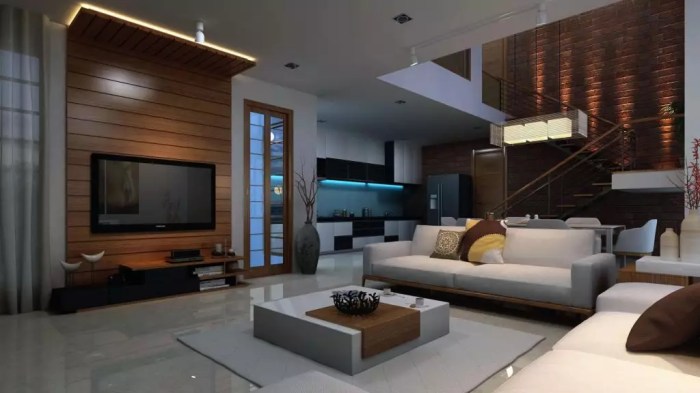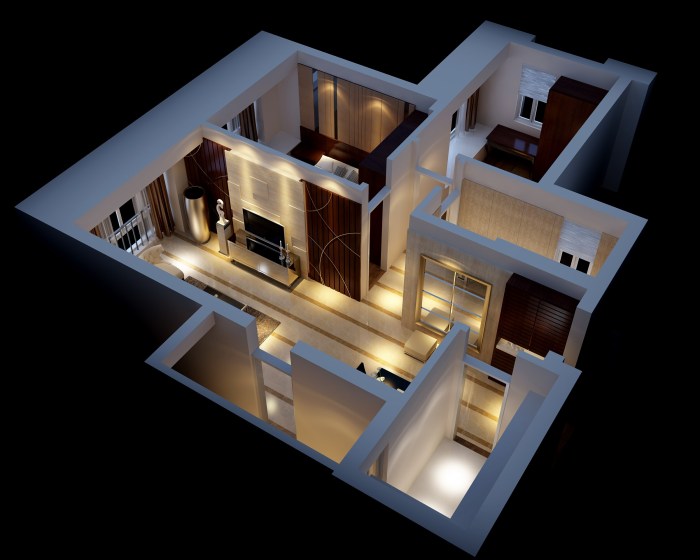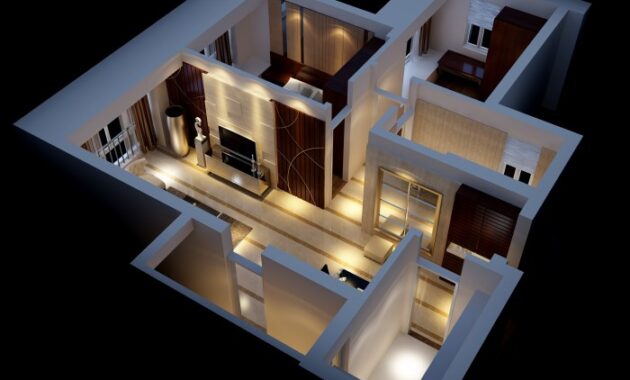3D design for house interiors has revolutionized the way we envision and create our living spaces. It allows homeowners, designers, and architects to bring their ideas to life before a single hammer is swung, offering a virtual preview of the final product.
This comprehensive guide explores the world of 3D design for house interiors, delving into its benefits, the software options available, and the key elements that contribute to a successful project. We’ll walk you through the process of creating a 3D model, from initial measurements to selecting furniture and decor.
We’ll also explore how 3D design is used for different interior styles, specific rooms, and even home staging. Join us as we unveil the possibilities of transforming your house into a dream home with the power of 3D design.
The Process of 3D Home Interior Design

D home interior design is a powerful tool that allows homeowners and designers to visualize their dream spaces before they are built. By creating a virtual model of the interior, designers can experiment with different layouts, materials, colors, and furniture arrangements, ultimately leading to a more efficient and aesthetically pleasing design.
The process of creating a 3D model involves several steps, each contributing to the final, realistic representation of the interior space. These steps involve careful planning, meticulous execution, and the use of specialized software tools.
Creating Accurate Measurements and Floor Plans
Accurate measurements and floor plans are the foundation of any successful 3D interior design project. They provide the blueprint for the virtual model, ensuring that all dimensions, shapes, and spatial relationships are correctly represented.
Before starting the 3D modeling process, it is essential to obtain accurate measurements of the existing space. This involves carefully measuring the length, width, and height of each room, as well as the position of doors, windows, and any existing fixtures.
The measurements should be recorded in a clear and organized manner, ideally in a spreadsheet or a dedicated floor plan software.
3D design for house interiors offers a powerful tool for visualizing and planning your dream home. It allows you to experiment with different layouts, materials, and colors before committing to any changes. For those with larger homes, especially those spanning three floors, 3 floor house interior design presents unique challenges and opportunities.
3D design becomes even more crucial in these instances, allowing you to see how the flow between floors will work and ensure each space feels cohesive. Whether you’re designing a grand staircase or a cozy nook, 3D design helps bring your vision to life.
Based on these measurements, a detailed floor plan is created. The floor plan serves as a visual guide for the 3D model, outlining the layout of the space, the position of walls, and the placement of doors and windows. The floor plan should be drawn to scale, ensuring that all proportions are accurate.
3D design for house interiors is a powerful tool for visualizing and planning spaces, especially when dealing with limited square footage. For instance, if you’re working with a small 20 square meter house, 20 square meter house interior design can be a great resource for inspiration.
3D modeling allows you to experiment with furniture placement, color palettes, and lighting to create a functional and visually appealing space, even in a compact environment.
Accurate measurements and floor plans are crucial for creating a realistic and functional 3D model. Any errors in these initial stages can lead to inaccuracies in the final design.
Creating a 3D Model of a Kitchen Space
Creating a 3D model of a kitchen space involves a step-by-step process that allows designers to visualize the space and experiment with different design elements. The process can be broken down into several stages:
- Import the Floor Plan:Begin by importing the accurate floor plan of the kitchen space into the 3D modeling software. This will serve as the foundation for the 3D model.
- Create Walls and Ceilings:Using the floor plan as a guide, create the walls and ceiling of the kitchen space. Pay attention to the height of the ceiling and any structural features like beams or columns.
- Add Doors and Windows:Place doors and windows in their correct positions according to the floor plan. Consider the size and style of doors and windows, as they can significantly impact the overall design and functionality of the space.
- Define the Kitchen Layout:Determine the placement of key elements such as the kitchen sink, stove, refrigerator, and cabinets. Consider the work triangle principle, which suggests that these elements should be placed in a triangular configuration to optimize workflow and efficiency.
- Add Appliances and Fixtures:Insert appliances like ovens, microwaves, dishwashers, and refrigerators into the model. Choose models that match the desired style and functionality. Also, add lighting fixtures, including overhead lights, pendant lights, and under-cabinet lighting.
- Select Materials and Finishes:Choose materials for countertops, cabinets, backsplashes, and floors. Experiment with different colors, textures, and patterns to create the desired aesthetic. Use the 3D software’s material library or import custom textures for a realistic representation.
- Add Furniture and Decor:Include furniture like tables, chairs, and bar stools. Consider the size and style of furniture to ensure it fits comfortably within the space. Add decorative elements like plants, artwork, and rugs to enhance the overall design.
- Render the Model:Once the 3D model is complete, render it to create a realistic image. Rendering involves using specialized software to simulate light and shadow, creating a photorealistic representation of the kitchen space.
Key Elements of 3D Home Interior Design: 3d Design For House Interior
Creating a realistic and inviting 3D home interior design requires a careful consideration of several key elements. These elements work together to transform a virtual space into a believable and appealing environment.
Lighting
Lighting plays a crucial role in setting the mood and atmosphere of a 3D interior design. It influences how colors appear, how textures are perceived, and how the overall space feels. Different types of lighting can be used to create specific effects:
- Ambient Lighting: Provides overall illumination, simulating natural light coming through windows or artificial light sources like ceiling fixtures. Ambient lighting helps to establish the general brightness and tone of the scene.
- Directional Lighting: Mimics the directionality of light sources, such as spotlights or lamps. This type of lighting creates shadows and highlights, adding depth and dimension to the space. It can be used to emphasize specific features or create dramatic effects.
- Accent Lighting: Highlights specific objects or areas, adding visual interest and creating focal points. It can be used to illuminate artwork, sculptures, or architectural details.
Color, 3d design for house interior
Color is an essential element in creating a visually appealing and harmonious interior design. It affects the mood, size, and functionality of a space. Color can be used to:
- Create a sense of spaciousness: Lighter colors, such as whites, creams, and pastels, can make a room feel larger and more airy. For instance, a small bedroom painted in a light blue can appear more spacious and relaxing.
- Define different areas: Using contrasting colors can help to visually separate different zones within a space, such as a living area from a dining area. For example, using a warm yellow for the living area and a cooler blue for the dining area can create a clear distinction between the two spaces.
- Set the mood: Colors can evoke specific emotions and feelings. For example, warm colors like red and orange can create a sense of energy and excitement, while cool colors like blue and green can promote relaxation and tranquility.
Texture
Texture adds depth and realism to 3D interior design. It provides a tactile element that engages the viewer’s senses and creates a more immersive experience. Different materials have distinct textures, such as the smooth surface of a marble countertop, the rough texture of a brick wall, or the soft texture of a plush rug.
3D Design Techniques for Creating Realistic Textures
| Technique | Description | Pros | Cons |
|---|---|---|---|
| Bump Mapping | Simulates surface irregularities by adding small displacements to the surface, creating the illusion of bumps and dents. | Creates realistic textures with minimal performance impact. | Limited in its ability to represent complex surface details. |
| Normal Mapping | Uses a texture map to store surface normals, which are vectors that indicate the direction of the surface at each point. This allows for the simulation of complex surface details without actually modifying the geometry. | Creates highly detailed textures with minimal performance impact. | Can sometimes create artifacts or visual inconsistencies, especially when used with highly complex textures. |
| Displacement Mapping | Modifies the actual geometry of the surface based on a texture map. This allows for the creation of highly detailed and realistic textures. | Creates the most realistic textures, as it actually modifies the geometry of the surface. | Can significantly increase rendering time and performance overhead. |
Furniture and Decor Selection in 3D Design

Selecting the right furniture and decor is crucial for a successful 3D home interior design. The right choices can transform a space from bland to beautiful, functional, and personalized. This process involves considering various factors, including style, function, and budget, to create a cohesive and visually appealing environment.
Guide for Furniture and Decor Selection
This guide Artikels a step-by-step approach to selecting furniture and decor for your 3D home interior design. It considers style, function, and budget to help you make informed decisions.
Style
- Define Your Style:Determine the overall aesthetic you want to achieve, such as modern, traditional, minimalist, or eclectic. This will guide your furniture and decor choices.
- Research Styles:Explore different interior design styles and their defining characteristics to gain inspiration and refine your preferences.
- Create a Mood Board:Collect images of furniture, colors, patterns, and textures that resonate with your chosen style. This visual representation will help you visualize the final design.
Function
- Consider Room Usage:Determine the primary function of each room, such as living, dining, bedroom, or home office. This will influence the furniture and decor choices.
- Prioritize Functionality:Select furniture and decor that serve a practical purpose, such as storage solutions, comfortable seating, and appropriate lighting.
- Evaluate Space Requirements:Measure your rooms carefully to ensure that furniture and decor fit comfortably and leave adequate space for movement.
Budget
- Set a Budget:Establish a realistic budget for furniture and decor, considering your overall project costs.
- Prioritize Needs:Allocate your budget to essential items first, such as comfortable seating and functional storage solutions.
- Explore Affordable Options:Research and compare prices from different retailers and consider purchasing used or refurbished furniture.
Living Room Design Example
This example illustrates how different furniture arrangements and decor options can create distinct looks within a living room.
Arrangement 1: Cozy and Inviting
- Furniture:A plush sectional sofa, a coffee table, two armchairs, and a floor lamp.
- Decor:Soft throw blankets, decorative pillows, a rug with a subtle pattern, and a bookshelf with personal items.
- Lighting:Warm, ambient lighting from the floor lamp and overhead lighting.
Arrangement 2: Modern and Minimalist
- Furniture:A sleek sofa, a low coffee table, a geometric rug, and a minimalist bookshelf.
- Decor:Minimalist artwork, a few strategically placed decorative objects, and a single, statement light fixture.
- Lighting:Bright, natural light supplemented by strategically placed task lighting.
Arrangement 3: Traditional and Elegant
- Furniture:A formal sofa, a mahogany coffee table, a pair of wingback chairs, and a crystal chandelier.
- Decor:Ornate artwork, antique vases, silk curtains, and a plush rug with a traditional pattern.
- Lighting:Warm, ambient lighting from the chandelier and table lamps.
Wrap-Up

From conceptualizing your dream home to bringing it to life, 3D design empowers you to visualize, refine, and personalize your living space. By understanding the process, key elements, and ethical considerations, you can leverage this powerful tool to create a home that reflects your unique style and fulfills your aspirations.
Whether you’re a homeowner, designer, or simply curious about the future of interior design, 3D design offers a glimpse into a world of endless possibilities.
Popular Questions
What software is best for 3D home interior design?
Popular options include SketchUp, Revit, 3ds Max, and Blender. Each software has its strengths and weaknesses, so choose one that best suits your needs and experience level.
Can I create a 3D model of my own home?
Yes, you can create a 3D model of your own home using software like SketchUp or by hiring a professional 3D designer. Accurate measurements and floor plans are essential for creating a realistic model.
How much does it cost to hire a 3D interior designer?
The cost of hiring a 3D interior designer varies depending on their experience, the scope of the project, and your location. It’s recommended to get quotes from several designers before making a decision.

